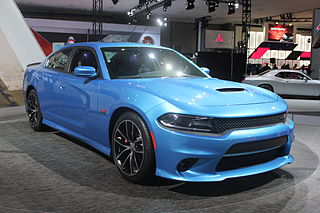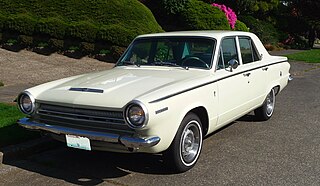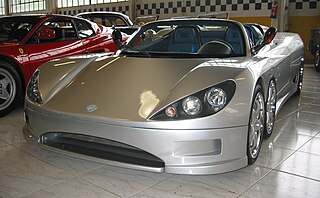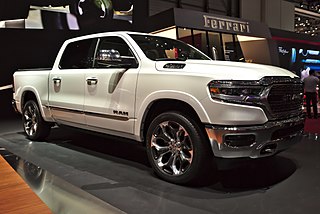
The Metro is a city car that was produced by British Leyland (BL) and, later, the Rover Group from 1980 to 1998. It was launched in 1980 as the Austin Mini Metro. It was intended to complement and eventually replace the Mini, and was developed under the codename LC8. The Metro was named by What Car? as Car of The Year in 1983 as an MG, and again as a Rover in 1991.

The Chrysler Cirrus is a mid-sized 4-door notchback sedan introduced by Chrysler motors for the 1995 model year. Built on the Chrysler JA platform, the 4-door notchback sedan joined Chrylser's roster of "Cloud Car" models drawing their names names from meteorological terms, including the mid-priced Dodge Stratus it was based on introduced at the same time, and the low-priced Plymouth Breeze variant a year later.

The Dodge Charger is a model of automobile marketed by Dodge. The first Charger was a show car in 1964. There have been several different production Chargers, built on three different platforms and sizes. In the United States, the Charger nameplate has been used on subcompact hatchbacks, full-sized sedans, and personal luxury coupes. The current version is a four-door sedan.

The Dodge Challenger is the name of three different generations of automobiles produced by American automobile manufacturer Dodge. However, the first use of the Challenger name by Dodge was in 1959 for marketing a "value version" of the full-sized Coronet Silver Challenger.

The Dodge Dart is an automobile originally built by Dodge from 1960 to 1976 in North America, with production extended to later years in various other markets. The Dart nameplate was resurrected for a Fiat-derived compact car introduced in 2013.

The Covini C6W is an Italian 2-seat 2-door sports coupé with a removable roof section. Inspiration for the car was taken from the 1976 Tyrrell P34, which had two pairs of smaller front wheels, a principle applied to the C6W. The project was started in 1974 but abandoned shortly after, and left dormant into the 1980s due to the lack of availability of low-profile tires at the time. In 2003 the project was revived and in 2004 the C6W was shown in prototype form. In 2005 a slightly revised version debuted at the Salon International de l'Auto, featuring new wheels, new roof structure and a refreshed interior, and went into limited production of 6-8 cars per year, as a result of a tie-up between PMI and Covini Engineering. The car features a rear, 4200 cc 8-cylinder engine and has a top speed of 186 mph (299 km/h).

The Ram pickup is a full-size pickup truck manufactured by FCA US LLC and marketed as of 2011 onwards under the Ram Trucks brand. The current fifth-generation Ram debuted at the 2018 North American International Auto Show in Detroit, Michigan.

The Dodge Dakota, known as the Ram Dakota for the final two years of production, is a mid-size pickup truck from Chrysler's Ram division. From its introduction through 2009, it was marketed by Dodge. The first Dakota was introduced in 1986 as a 1987 model alongside the redesigned Dodge Ram 50. The Dakota was nominated for the North American Truck of the Year award for 2000. The Dakota has always been sized above the compact Ford Ranger and Chevrolet S-10, but below the full-sized pickups such as Dodge's own Ram. It is a conventional design with body-on-frame construction and a leaf spring/live axle rear end. The Dakota is the first mid-size pickup with an optional V8 engine. One notable feature was the Dakota's rack and pinion steering which was added as a part of the 1997 re-design, a first for work trucks. Dakotas have been used by police and fire departments, as off-road vehicles, patrol trucks, or even brush trucks.

The Dodge Durango is a mid-size sport utility vehicle (SUV) produced by Dodge. The first two generations were very similar in that both were based on the Dodge Dakota, both featured a body-on-frame construction and both were produced at the Newark Assembly Plant in Newark, Delaware.

The Chrysler Town & Country is a station wagon that was manufactured by Chrysler from 1940 to 1942 and from 1945 to 1988. The Town & Country was also available in four-door sedan, two-door hardtop, and convertible body styles from 1947 to 1950 and from 1983 to 1986. The 1988 model year was the last for the Chrysler Town & Country station wagon, after that and partly during one model year (1989), the Town & Country nameplate was off the market until the 1990 model year run when Chrysler re-introduced the Town & Country nameplate as a rebadged variant Chrysler Town & Country minivan.

The Volkswagen W12 Coupé was a concept car created by Volkswagen Passenger Cars in 1997. The car is portrayed in games, such as Gran Turismo, Asphalt 8, Project Gotham Racing 3, GTI Racing, and the Test Drive series. This car also featured in an April Fools joke as the new Volkswagen LeVanto.

The Dodge Ram SRT-10 is a sport pickup truck that was produced by American automaker Dodge in limited numbers. It was introduced at the January 2002 North American International Auto Show, but was not put into production until 2004.

In 1999 Dodge debuted a new Dodge Charger R/T concept car. It took many styling cues from the 1960s Chargers but also had four doors. The designers attempted to blend the rear doors into the design so they would not be noticed very easily. Compressed natural gas was purported as being in the lineup for a possible fuel source.

The Ford Interceptor is a concept car which debuted at the 2007 North American International Auto Show in Detroit, Michigan. The Interceptor is a retro-styled sedan that reflects a modern interpretation of the classic sporty American muscle cars from the 1960s, like the Ford Galaxie. Ford officially introduced the Interceptor Concept in a company press release dated 31 December 2006. Ford describes the Interceptor design styling as being influenced "...much like a Marine in dress uniform. He looks smart and elegant but you can see the raw power that lies beneath." Ford currently has no production plans for such a full-sized, rear-wheel drive sedan, although some of the Interceptor's design cues have appeared in the sixth-generation Ford Taurus.

The Dodge Viper is a sports car manufactured by Dodge, a division of American car manufacturer FCA US LLC from 1991 through 2017, having taken a brief hiatus from 2010–2013. Production of the two-seat sports car began at New Mack Assembly Plant in 1991 and moved to Conner Avenue Assembly Plant in October 1995.
The Dodge Venom was a concept car that was produced in 1994 by the American automaker Dodge. The car was built on a modified version of the Chrysler PL platform that was used in the Dodge Neon. The car was designed to showcase Dodge's Cab-Forward design in a two-seat sports car package. Although based on the Neon, the upgraded V6 engine and rear wheel drive set gave this car a sports appeal. The car featured a 3.5-liter, overhead-cam, 24-valve V6 engine that was able to put out 245 horsepower and 221 pound-feet of torque at 2,800 rpm. It was debuted along with two other concept cars on January 3, 1994. The cost was projected to cost $8,975, $13,000 "fully loaded".

The Dodge Copperhead,, was a concept car created by Dodge as a slimmed-down version of the Dodge Viper for buyers who couldn't afford the Viper's $75,000 cost.
Toyota Concept Vehicles produced between 1980 and 1989 include:

The Porsche 911 is a two-door, 2+2 high performance rear-engined sports car made since 1963 by Porsche AG of Stuttgart, Germany. It has a rear-mounted flat-six engine and all round independent suspension. It has undergone continuous development, though the basic concept has remained unchanged. The engines were air-cooled until the introduction of the Type 996 in 1998, with Porsche's "993" series, produced in model years 1994–1998, being the last of the air-cooled Porsches.
The Jaguar Kensington is a concept car designed and built by Italdesign for Jaguar. It debuted as a non-running, full-size mock up at the 1990 Geneva Motor Show, and later as a fully functioning prototype at the 1990 British International Motor Show.




















